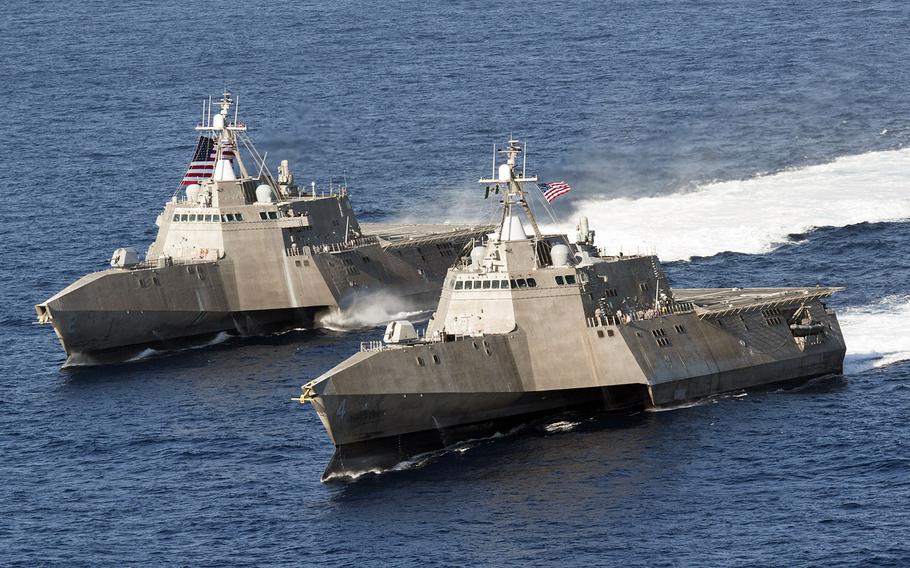
The littoral combat ships USS Independence (LCS 2), left, and USS Coronado (LCS 4), underway in the Pacific Ocean in April, 2014. President Obama's 2016 budget request includes funding for three more of the ships. (Keith DeVinney/U.S. Navy)
WASHINGTON — The Navy is hoping for an 8 percent increase in its budget from last year, as the service seeks to bring aboard more sailors and build more ships.
President Barack Obama’s fiscal 2016 budget request, unveiled Monday, calls for the Navy to receive $137 billion for its base budget. That’s $9.7 billion more than it received this fiscal year, and billions more than the Navy will be allowed to spend if the congressionally imposed budget cap known as “sequestration” isn’t lifted.
The service is also requesting $5.6 billion for “overseas contingency operations”, also known as OCO.
At a time when the size of the Army is being slashed, the Navy wants to add about 5,600 people to its active duty rolls and increase the number of ships in the fleet.
There are currently 323,000 active duty sailors in the Navy. That number would increase to 329,200 in fiscal 2016 if the Navy gets its way. Navy Reserve end strength would remain roughly the same at 57,400.
At a time of high operational tempo, sailors will continue to see higher sea pay, incentive pay for critical skill sets, and bonuses for those who undergo extended deployments. Obama has proposed that military basic pay and civilian pay increase 1.3 percent in fiscal 2016.
The Navy is seeking a fleet increase from 271 to 282 ships. The USS Gerald R. Ford aircraft carrier will come into service in 2016, keeping the number of available carriers at 10 while the USS George Washington undergoes refueling. Thirteen other battle force ships will be delivered, including two nuclear attack submarines, five Littoral Combat Ships, two Joint High Speed Vessels, three destroyers, and an Amphibious Transport Dock. Three nuclear attack submarines will be retired.
The request calls for about $33 billion in Navy procurement funding for fiscal 2016 to buy new ships and aircraft, including:
2 nuclear attack submarines (SSN) 2 destroyers (DDG 51) 3 Littoral Combat Ships (LCS) 1 amphibious transport dock (LPD 17) 4 F-35C Joint Strike Fighters (carrier variant) 16 P-8A Poseidons (MMA) 5 E-2D Hawkeyes 3 MQ-4C Triton unmanned aircraft 2 MQ-8C Firescout unmanned helicopters Detailed design and construction of the USS John F. Kennedy aircraft carrier (with estimated delivery in fiscal 2018) The Navy aims to have a 306-ship fleet by fiscal 2020.
The planned naval buildup comes at a time when China is undergoing rapid military modernization and its forces pose a growing threat to American dominance of the high seas. The Navy is playing a leading role in the Pentagon’s rebalance to the Asia-Pacific, and the service intends to have 60 percent of its fleet based in the region by 2020.
harper.jon@stripes.com Twitter: @JHarperStripes